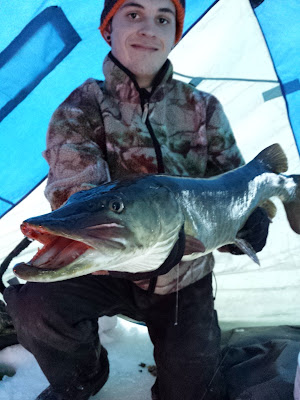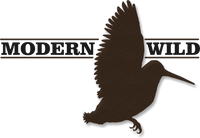 "Did you get the whole fish in frame?" asked my trembling friend touting a 36 inch muskie, his first ever, that he had just played tug of war with using 4lb test and Medium-Light ice rod, ultimately squeezing it through a six inch ice hole. "Yeah I got it. The picture looks great!" I showed my friend who smiled ear to ear in the glow of my cell phone screen. Seconds later he slipped the stout muskie back into the oily black water. As its freckled tail slithered through his fingers the familiar fragrance of muskie slime remained in the air of our toasty portable ice house. Certainly the long lasting smell would be a foreshadowing of the memory created. Later that year I was showing a different friend pictures on my phone of the memorable fish we had caught that winter.
"Did you get the whole fish in frame?" asked my trembling friend touting a 36 inch muskie, his first ever, that he had just played tug of war with using 4lb test and Medium-Light ice rod, ultimately squeezing it through a six inch ice hole. "Yeah I got it. The picture looks great!" I showed my friend who smiled ear to ear in the glow of my cell phone screen. Seconds later he slipped the stout muskie back into the oily black water. As its freckled tail slithered through his fingers the familiar fragrance of muskie slime remained in the air of our toasty portable ice house. Certainly the long lasting smell would be a foreshadowing of the memory created. Later that year I was showing a different friend pictures on my phone of the memorable fish we had caught that winter. "Woah, that's a nice muskie! You guys caught that through the ice here? How long was that?"
"Thirty-six inches, but it was heavy for its size, probably ten or twelve pounds. It was his first one," I exclaimed, attempting to recollect the heft of the fish with my hands.
"Oh... I thought it was way bigger than that... Hah! Geeze, your friend has some long arms. Could he have held it any closer to the camera?"
Conversations like these appear on social media all the time. Phrases like 'long-arming', 'the ten step rule', and my favorite 'I could make all my fish look that big if I took pictures that close to the camera'. Although these phrases are true in terms of using the picture to get an accurate estimation of size, the question is, is this really why we take pictures? I believe the solution to this is found in the answer to another question: Why do YOU spend time outdoors?
Whether it's systematically stalking speckled brookies on a small forest stream, or swinging streamers for steelhead at the mercy of a flowing muddy monster. We find that the reason we go back isn't truly to catch a bigger fish than before (though it's certainly a bonus); rather, we gravitate toward more subjective reasons. The pleasant feeling of crisp morning air on our face. The sight of trout slurping mayflies from the surface film of a stream colored gold by sunset. The smile of a friend as he hefts his first smallmouth over eighteen inches. The feeling of setting the hook and getting a solid tug in response. The crash and thrum of grouse wings bursting from a nearby trail side cover. The feeling of cool stream water passing through your fingers as you admire the pearlescent coloring of an elk hair caddis eating brookie in hand. What does any of this have to do with pictures? Simple. It has everything to do with them. It's these small things, that when incorporated, turn pictures into moments other people can join and experience as well.
An example of capturing a little thing.
My brother Aaron and I were fly fishing for smallmouth earlier this year. We combed shorelines with our polarized glasses trying to catch sight of any footballs cruising off the edge of a rock bar. It wasn't long until we spotted a pair of decent sized fish circling like sharks in and out from the shadow of a massive boulder. Without hesitating I flicked my rod, lifting the black and white streamer tied to the line out of the water into flight. False casting once, I dropped the streamer right where I wanted it among the deep shadow of the jutting boulders. After waiting a few moments, I stripped my fly all the way to the boat with the fish seeming uninterested in my presentation. Seconds later, Aaron's ultra heavy brown streamer he had dubbed "The Dredge" crashed into the same spot. The bigger fish out of the pair appearing enraged smashed The Dredge, and a few minutes later Aaron was holding the eighteen inch beautifully marked fish in hand, heavy brown streamer hanging from its mouth. Although not the biggest smallmouth we have caught, I was taken with its markings. I took the camera and got within inches, snapping photos, paying attention to the lighting so that the markings of the fish came out as much as possible. The end result was a picture where the fish's size wasn't what mattered, but its beauty, and the humor of Aaron's heavy, yet effective, fly hanging from the fish's lips.
 |
-Adam Regier

